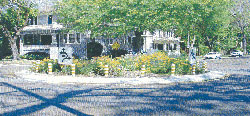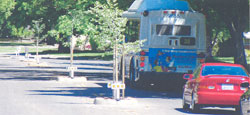Traffic Calming Guidelines
Sacramento, California
Source: Pedestrian and Bicycle Information Center (PBIC)

Planted mini-circle.
Problem
The City of Sacramento lacked a cohesive guide explaining the advantages and disadvantages of various traffic calming treatments that could potentially improve pedestrian safety.
Background
The Traffic Calming Guidelines were developed by the City of Sacramento's Department of Public Works to provide tools for citizens, Public Works staff, and other interested parties to help choose appropriate traffic calming devices that adequately accommodate motor vehicles, pedestrians, and bicyclists.
Solution
The final 70-page Traffic Calming Guidelines publication not only specifies a toolbox of traffic calming measures, but also defines the process to follow for retrofitting existing neighborhoods, the probable results of the measures, and standard designs for the implementation of traffic calming measures. It lists advantages and disadvantages to various treatments and provides illustrative pictures, estimated costs, and impacts.

Diverters with newly planted trees.
The process starts when a neighborhood has been identified for inclusion in the traffic management program. It begins by establishing a Traffic Calming Committee that takes a proactive role in creating a plan for their neighborhood and meets regularly with Public Works staff. The Guidelines toolkit is a key element in the education and communication between planners and residents. Once these changes are made, such as enforcement and educational components, an evaluation period takes place. At this point in the process the City staff present a report to the neighborhood, and if necessary, further measures are considered.
Partners included the Planning and Fire departments, the City School District, Walk Sacramento, Sacramento Area Bicycle Advocates, and Dan Burden's Walkable Communities. Funding was provided through a combined effort of the City of Sacramento, the State of California Office of Traffic Safety, the Business, Transportation, and Housing Agency, and the Federal Highway Administration. The total cost for the development of the guidebook was approximately $27,000.
Results
The City of Sacramento adopted the Guidelines to assist the public, city staff, consultants, and developers in creating a safer environment for pedestrians by identifying traffic calming devices and steps for implementation. Speeds were reduced in local neighborhoods, and new neighborhoods were designed from the start to promote reduced speeds.
Contact
Mark Hanneman, City Traffic Engineer
Department of Public Works
Traffic Engineering Services
1000 I Street
Suite 170
Sacramento, CA 95814-2806
(916) 264-5307
Images Source
Mark Hanneman, Sacramento Department of Public Works.




